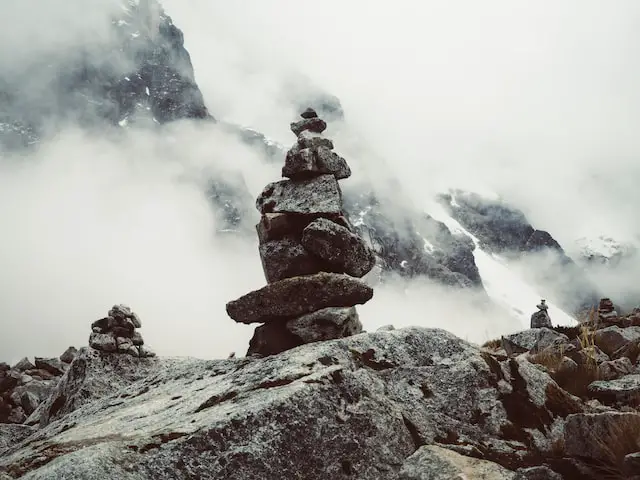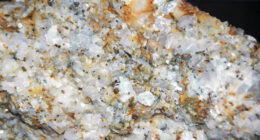Boulders are generally larger than rocks, and they often have a more defined shape. They can also be used for different purposes – Rocks are typically used for construction or landscaping, while boulders are often used for decorative purposes.
What is a boulder?
(Photo by Kristen Sturdivant on Unsplash )

A boulder is a large rock that is typically bigger than 10 inches in diameter. It is formed through natural geological processes like erosion, weathering, and glaciation. Boulders are usually found in areas with high amounts of rock outcroppings or in places where rocks have been moved by natural forces like landslides or rivers. They can be made up of various materials like granite, limestone, sandstone, or volcanic rock. Due to their size and weight, boulders are often used as landscaping features or as building materials. They can also be a hazard in areas prone to rockslides or falling rocks. Overall, boulders are an interesting and important geological feature that can provide insight into the history and geology of an area.
What is a rock?
(Photo by Joeri Römer on Unsplash )

A rock is a naturally occurring solid substance made up of minerals or mineraloids. Rocks are found all over the Earth and can be classified into three main types: igneous, sedimentary, and metamorphic. Igneous rocks are formed from the solidification of molten rock or magma, while sedimentary rocks are formed from the accumulation and cementation of sediments. Metamorphic rocks are formed from existing rocks that have undergone changes due to high heat, pressure, or chemical reactions.
Rocks come in various sizes and shapes and can be composed of different minerals or mineraloids. Some rocks, like granite, are used as building materials, while others, like marble, are used for sculpture and decorative purposes. Rocks can also provide important information about the Earth’s history and geology, including the conditions under which they formed and the types of processes that have affected them over time. Overall, rocks are an important part of the natural world and play a crucial role in the Earth’s geological processes.
Boulder Vs. Rock – Key differences
Boulders are a type of rock that are typically larger than 10 inches in diameter, while rocks can vary in size from pebbles to mountains. Boulders are often found in areas with high rock outcroppings or where rocks have been moved by natural forces, while rocks are found all over the Earth. Boulders are also often used as landscaping features or building materials due to their size and weight, while rocks can have a variety of uses depending on their composition and size. Additionally, boulders are often formed through natural processes like erosion and weathering, while rocks can be formed through a range of geological processes including solidification, sedimentation, and metamorphism.
Types of rock
There are three main types of rock: igneous, sedimentary, and metamorphic.
Igneous rocks are formed from the solidification of molten rock or magma. They can be intrusive, meaning they form below the Earth’s surface and have a coarse-grained texture, or extrusive, meaning they form above the Earth’s surface and have a fine-grained texture. Examples of igneous rocks include granite, basalt, and obsidian.
Sedimentary rocks are formed from the accumulation and cementation of sediments. They can be clastic, meaning they are made up of small particles of other rocks or minerals, or chemical, meaning they are formed through chemical precipitation. Examples of sedimentary rocks include sandstone, limestone, and shale.
Metamorphic rocks are formed from existing rocks that have undergone changes due to high heat, pressure, or chemical reactions. They can be foliated, meaning they have a layered or banded appearance, or non-foliated, meaning they do not have a layered appearance. Examples of metamorphic rocks include slate, marble, and gneiss.
There are also many subcategories of each of these main rock types based on their specific mineral composition and other factors.
Types of boulders
Boulders are classified based on their composition and the process by which they were formed. Here are some types of boulders:
Granite boulders: Granite is a common type of boulder that is formed through the cooling and solidification of magma or lava. It is composed of quartz, feldspar, and mica.
Basalt boulders: Basalt is a dark-colored volcanic rock that is formed through the cooling and solidification of lava. It is composed of minerals like plagioclase, pyroxene, and olivine.
Sandstone boulders: Sandstone is a sedimentary rock that is formed through the accumulation and cementation of sand grains. It can have a variety of colors and textures depending on the type of sand grains it is composed of.
Limestone boulders: Limestone is a sedimentary rock that is formed through the accumulation and cementation of shell fragments, coral, and other organic matter. It is composed mainly of calcium carbonate.
Quartz boulders: Quartz is a mineral that can form large boulders, often with a milky or translucent appearance. It is composed of silicon dioxide.
Conglomerate boulders: Conglomerate is a sedimentary rock that is formed through the accumulation and cementation of rounded pebbles and other rock fragments. It can have a variety of colors and textures.
There are also many other types of boulders that can be found in different regions, depending on the local geology and environment.
How is a boulder formed?
A boulder is typically formed through a process known as weathering and erosion. This occurs when a rock or mountain is exposed to the elements over a long period of time. Water, wind, and other forces slowly break down the rock, causing it to become smaller and more rounded. As the rock continues to erode, it may eventually break off and become a boulder. Another way a boulder can form is through volcanic activity. Molten lava can cool and solidify into a large, rounded rock as it flows down a volcano or other landscape. Additionally, glaciers can also transport and deposit large boulders over long distances.
How is a rock formed?
Rocks can be formed through three main processes:
Igneous rocks are formed when magma or lava cools and solidifies. If the cooling occurs beneath the surface of the earth, intrusive rocks are formed, such as granite. If the cooling occurs above the surface, extrusive rocks are formed, such as basalt.
Sedimentary rocks are formed from sediment that has been deposited over time and then compacted and cemented together. Sediments can include sand, mud, shells, and other organic materials. Examples of sedimentary rocks include limestone, sandstone, and shale.
Metamorphic rocks are formed when existing rocks are subjected to high pressure, high temperature, or chemically active fluids, causing them to change into a new type of rock. For example, shale can be transformed into slate, and limestone can be transformed into marble.
Each rock type has unique characteristics based on its formation process, including its texture, color, and mineral composition.









